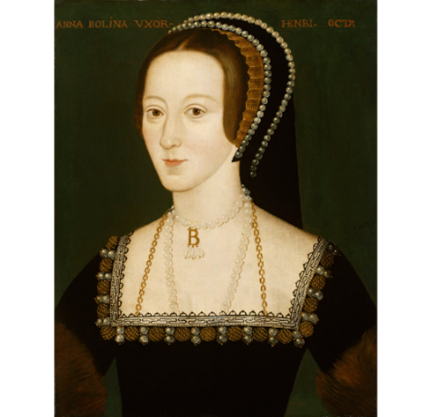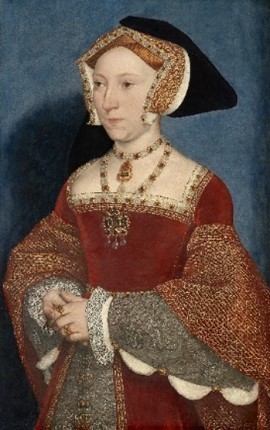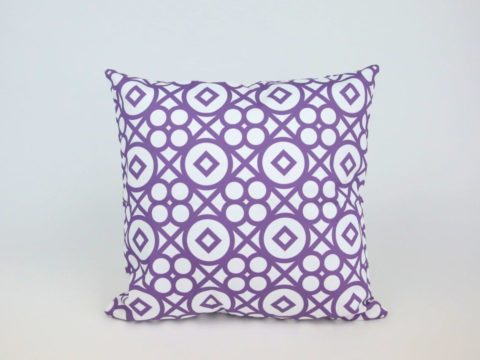Pictures and Patterns of a Merciless Prince
by Linda Collins and Siobhan Clarke
Within 24 hours, in May 1536, Anne Boleyn was executed and Jane Seymour was betrothed; King Henry VIII the catalyst in these two inextricably linked events. Portraits of Henry have remained fixed in the nation’s consciousness for the past 500 years, but of his queens, there are few existing contemporary paintings.

Early English Portraits
This picture of Anne Boleyn is by an English artist, possibly copied from a contemporary lost original and produced around 50 years after her death. The work is unsigned, as the English painter of the early 16th century had little status. By Tudor reasoning, it was the patron who commissioned and paid for the portrait who was important, with the artist viewed simply as an employed craftsman. There was no English ‘school’ of art, and the English did not even use the word ‘painting’. An image on an oak panel such as this was referred to as a ‘table’.
Of the numerous émigré painters in London during the early Tudor period, it was the skill of the Netherlandish artists that was most sought after and praised, although Holbein’s arrival in the city from Germany in 1526 and again in 1531 did much to raise the status of the artist in England.
Anne Boleyn was Holbein’s first royal patron. He designed an arch for her coronation and in 1534, a rose water table fountain for her to present to Henry. The historian Eric Ives described it as, ‘a pumped device which circulated rosewater into a basin so that diners could rinse their hands’. After Anne’s death, it was ironically Holbein who painted the portrait of her successor: Jane Seymour.
Before 1540, all portraits in England were painted on wooden panels, with canvas not becoming common for at least another 50 years. The oak panels on which both Anne and Jane are painted were imported into London from the Eastern Baltic, the area today around Poland. They were preferred by artists for their superior quality and smooth, even texture. Dendrochronology (the dating of a panel by tree rings) indicates that the panels on which Anne is painted came from trees felled after 1584, confirming the attributed date of the picture as the late 16th century. Jane was painted from life by Holbein in 1536/7.
Eyes which are Black and Beautiful
More than half a century after her death, Anne’s true image would no doubt have been forgotten, but infra-red reflectography (a method of ‘seeing through’ paint layers normally impenetrable to the human eye) confirms that her details were taken from a pattern, perhaps that of a lost contemporary portrait. Under-drawing can be seen through the thinly applied painting of the flesh, revealing that her face has been slimmed and her left shoulder lowered. Her famous necklace of pearls and the gold chain with its ‘B’ for Boleyn monogram was re-positioned before the picture was completed, but the jewellery was accurately reproduced. It is likely Anne’s eyes were painted first and coloured with a brown glaze to heavily define them. The artist is probably referring to contemporary accounts of Anne’s appearance that makes special note of her ‘black and beautiful eyes.’
Francesco Sanuto, the Venetian diplomat, described Anne as: not one of the handsomest women in the world; she is of middling stature, swarthy complexion, long neck, wide mouth, a bosom not much raised and eyes which are black and beautiful. The ideal Tudor woman had very fair skin, blonde hair and blue eyes so many contemporaries thought Anne too dark to be a real beauty. However, later reports of deformities, such as a sixth finger and a large wen under her chin, were disseminated by Anne’s Catholic enemies and unlikely to be true.
The French poet, Lancelot De Carles, also praised her eyes: always most attractive which she knew well how to use with effect. Sometimes leaving them at rest and at others, sending a message to carry the secret witness of the heart. And, truth to tell, such was their power that many surrendered to their obedience.
Today, Anne’s portrait does not convey to us an image of great beauty but she may have been one of those people whose appeal requires animation. Elegant, accomplished and highly intelligent; her sexual allure most likely emanated from personality and charisma. She was so stylish she seemed like ‘a French woman born” and Henry found her completely fascinating.
However, the Kings’ ardour had cooled by 1536. Early that year, Anne’s miscarriage (of a male foetus) ensured her downfall and Jane Seymour’s rise. Henry courted Jane openly, advancing her brothers at court and sending her expensive gifts. Anne was arrested in May that year and sent to the Tower of London, where she was put on trial. Historians have long viewed the charges against her - adultery, incest, and plotting to kill the King - to be unconvincing. It is likely that her fall was engineered by Thomas Cromwell, acting in accordance with Henry’s wish to free himself.
Anne was imprisoned in the same royal apartment where three years earlier she had awaited her coronation. Her execution date was set for the 18 May. In the early dawn of the fateful day, Anne made her last confession, celebrated Mass, and prepared herself for the walk to the scaffold. However, news arrived that her beheading had been postponed to the following day and she was returned to her chambers for another night of torment.
The next morning, dressed in grey damask trimmed with ermine, she was led to the scaffold. Ermine denoted her royal status, and beneath the grey damask could be glimpsed a gown of red, the colour of martyrdom. Spectators gathered around the black draped scaffold to await her brutal demise. She is said to have remarked to her ladies-in-waiting that, ‘I heard the executioner was good and I have a little neck’.
Henry had shown Anne ‘leniency’ by employing a swordsman from Calais instead of condemning her to a painful death by burning, or of submitting her to the numerous misguided blows of an axe that could and often did, precede the removal of a head. The executioner readied a honed sword of Flemish steel, 2 or 3ft long with a 2” double edged blade that had a groove channelled into it, allowing the blood to run off without blunting the instrument.
Kneeling upright on the scaffold, her eyes blindfolded with a cloth of linen, Anne’s head was severed from her body with one skilled blow. It was immediately covered with a white handkerchief and lay there for hours as no-one had prepared for her burial. Eventually, her body was placed in a makeshift empty chest and taken to the Chapel Royal at St Peter ad Vincula within the walls of the Tower.
This destruction of Henry’s second queen, combined with his mistreatment of the first, began to cement the King’s reputation in Europe as a ruthless and undesirable husband, as witnessed by the later comments of Christina, Duchess of Milan, that she would marry the king of England only if she had an extra head.
As the canons fired to signal Anne’s death, Henry was rowed to Chelsea to visit Jane Seymour. His intention to wed Jane was announced to his Council that same day, and the following morning, the couple were formally betrothed at Hampton Court Palace. The official marriage ceremony took place on 30th May at Whitehall, the largest palace in Europe that stretched from Charing Cross to Westminster Hall.

Bound to Obey and Serve
This contemporary portrait of Jane Seymour is by the supremely talented Hans Holbein the Younger and painted towards the end of her life. Today, the chalk preparatory drawing is in the Royal Collection at Windsor Castle and the painting is housed in the Kunsthistorische Museum, Vienna.
Jane is wearing a red velvet gown with sleeves of cloth of gold, and an English style gabled headdress in preference to the more daring French hood, that would reveal some of her hair. Her rich clothing and jewels have been painted with great care, emphasising her status as queen. Gold, pearls and precious stones are especially well portrayed, along with the silver thread in her slashed fore-sleeves and kirtle.
Holbein had been appointed court painter during his second visit to England in 1535 and his ability to create a physical presence was unrivalled. One of his patrons, the poet, Nicholas Bourbon, described his work as ‘pictures that perfectly resemble life.’ It seems Henry was happy with the portrait of his new wife. Within the year, Holbein was commissioned to produce one of the greatest portraits of his career; a mural of Henry himself on the wall of the King’s Privy Chamber in Whitehall Palace.
Celebrated for his frank and revealing sketches, (which can be viewed today in the Royal Collection), Holbein does not flatter his sitter. His portraits of Jane reveal a rather long narrow nose, a pointed chin, a small, thin-lipped mouth, with pale eyelashes and eyebrows. The Imperial Ambassador described her as, ‘no great beauty’, leaving him to surmise that her attraction might lie in other areas of the King’s life. As lady in waiting to both Katherine of Aragon and Anne Boleyn, Jane was well-informed on the intricacies and scandals of the Tudor Court. She was about 28 years old when she married – rather late for a Tudor bride - but she was noted for her virtue and her family were known for their fertility.
The new Queen’s motto was ‘Bound to obey and serve’, making it clear that she wanted to be a submissive wife. Where Anne had been ruthless, Henry believed Jane to be naturally compassionate. He would in years to come remember her as: the fairest, the most discreet, and the most meritorious’ of all his wives. It is possible she reminded him of his mother, Elizabeth of York, who was gentle and played little part in politics. However, Jane was also capable of being strict: she carefully controlled her ladies and made sure that her household was known for its virtue.
In the spring of 1537 it was announced, at a meeting of the Privy Council, that the Queen was pregnant and soon the good news spread across the country. She experienced a trouble-free pregnancy and, when she craved quail, the devoted Henry ordered them for her from France.
Jane finally succeeded where Henry’s other queens had failed and, at Hampton Court Palace she gave birth to a healthy boy. The birth of the child was long and difficult, taking two days and three nights. Finally, at 2am on Friday 12th October, the eve of St Edward’s Day, Jane’s labour ended. Henry was at Esher when he heard but sped back to Hampton Court, commanding that every room and hall in the newly built nursery be swept and washed, ready for the prince.
Master Secretary, Thomas Cromwell, wrote that the announcement: hath more rejoiced this realm and all true hearts … more than anything hath done this 40 years. The Queen appeared to recover quickly and sent out personally signed letters announcing the arrival of: a Prince, conceived in most lawful matrimony between my Lord the King’s Majesty and us.
Just three days after his birth, the baby was baptised, in the Chapel Royal at Hampton Court in a lavish ceremony. Jane was well enough to receive Christening guests in her apartments but became ill the next day. On the evening of the 23rd October, Henry was summoned to her bedside as it was obvious that she was dying. In the early hours of the next day, Jane died either from a retained placenta or puerperal fever due to a bacterial infection contracted during the birth. Eleven years later Catherine Parr would suffer the same fate.
Henry was devastated and hid himself away at Windsor, refusing to see anyone. He wore full mourning for three months and wrote to Francis I of France that: Divine Providence ... hath mingled my joy with bitterness of the death of her who brought me this happiness.
Jane was the only one of his wives to receive a magnificent state funeral and she is the queen he chose to be buried alongside at St George’s Chapel, Windsor. For the more sceptical, she is also the wife who presented him with a longed-for son, and then died, before he fell out of love with her.
Consider these two portraits of Henry’s queens. We see the slender neck and black eyes of Anne Boleyn, and the plain, pale countenance of Jane Seymour. The artists have given us the images we have come to expect, but looking more deeply into their eyes, we can only wonder at how much or how little they were in control of their own destiny, and pity them the fear they must both have experienced nearly 500 years ago when, by different means, they met the same end.
Henry took another three wives and lived on for 11 years until January 1547, when he joined Jane Seymour, ‘the only wife he ever loved’, in the vault of St Georges Chapel, Windsor Castle.




